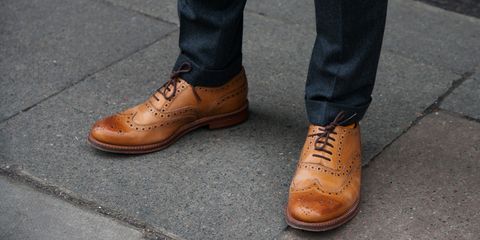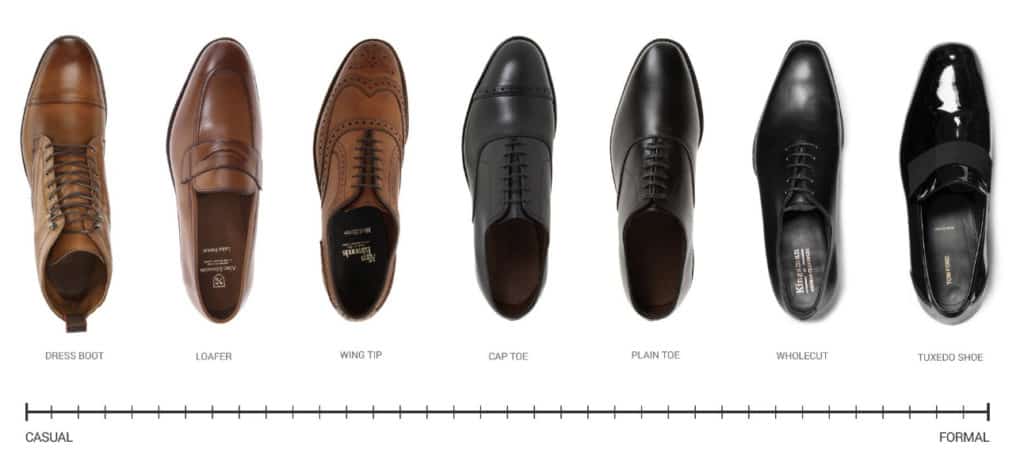There are more unique, distinctive styles of footwear you can buy today than at any point in history. Everything from running shoes, basketball shoes, sneakers, sandals, Crocs, high heels, pumps, and dress shoes, each with its own individual styles and function. Depending on what they are using them for, men can choose between sneakers, slip-ons, boat shoes, cowboy boots, sandals, moccasins or dress shoes. Some of these styles have heels, while others don’t. You wouldn’t want heels on running shoes because you’d want your feet to be parallel to the ground and flat to void injury. On the other hand, men’s dress shoes have heels, although at first glance the heels don’t serve any special function.
We ask, why do men’s dress shoes have heels? While the history of heels on men’s shoes is engrossing and ultimately revealing about human vanity, the reason heels are still found on shoe today is to help keep the heel of the shoe from wearing out too quickly. The heel preserves the life of the shoe.
Humans are bipedal, and when walking we step onto the heel of the feet first, and over time the back part of the shoe wears out first. But the history of heels on men’s dress shoes gives us a fascinating look at the past and how men’s (and women’s) shoes evolved into their modern form.
Table of Contents
The ‘Horseback’ History of Boots and Heeled Shoes
Feet are placed in stirrups when riding a horse. The first men’s heels were placed on dress shoes not for style, but for practical reasons. Back 500 years ago in the 1500s, in the part of the world that is now the country of Iran, men traveled mainly by horseback. With the addition of shoe heels, they not only were more secure in the stirrups, but heels allowed them to stand up while riding and shoot arrows at an enemy without risk of falling out of the saddle.
Persians form Mesopotamia traveled throughout Europe from modern-day Iran and Iraq and their heeled shoes were seen as a sign of masculinity. This led to the manufacture of heeled shoes in Europe, and it became stylish to wear heeled dress shoes among the aristocracy.
It was decreed that only men of nobility were allowed to wear heeled shoes. Their popularity grew until the outbreak of war in the late 1700s in what ultimately became the French Revolution. Revolutionaries rejected high heeled shoes since they represented the aristocracy they sought to overthrow. After their success in defeating the noblemen, heeled shoes went out of style for a period of time.

Men’s shoes then moved from design-based to functional wear. Shoes become more practical, but a small heel still retained its place on the back of the shoe. Why was this so?
Heels not only prevented the back of the shoe from wearing out while the rest of the shoe was like new. Men who wore heels rose in vertical height and so appeared to be taller. This was important because heels on women’s shoes came into vogue, and women’s heels were much higher than men’s heels. Also, men of shorter stature, such as Napoleon, could appear taller and more dominant by wearing heels.
Today, there are many different materials used to make a shoe. The materials on better shoes such as soft rubber and leather, help quality shoes last a long time, and whatever wear occurs will be even across the length of the dress shoe.
The Shoe Heels of today provide both style and function
Dress shoes today have heels for much the same reason they did in the past. The high-heeled shoes worn by male royalty in the past were flamboyant and a bit on the pretentious side. The designs were often “flowery” and didn’t serve any function. Shoes back then communicated to the viewer that the wearer was superior, able to afford unique and expensive footwear.

Today men’s shoes often communicate the same thing, but with much more subtlety. Modern day dress shoes were men are not ostentatious and showy like men’s shoes of the past. Functionality and style combined now make the most attractive footwear. Some of the most attractive men’s shoes are the ones that contain quality materials and that are the most sensible.
What Materials go into high-quality Men’s dress shoes?
Men shouldn’t assume that just because a dress shoe costs $500.00 means it is a comfortable and well-made shoe. Some manufacturers have succeeded at branding their product as superior, yet there are less expensive alternatives that may actually be better quality.
Components to look for in a high-quality shoes that are attractive, comfortable and functional include the following.
Goodyear welt
Shoe construction includes material for the shoe upper and the shoe’s base. In Goodyear welt construction, a welt is stitched into the shoe’s upper, while a strip of canvas formed in the shape of the shoe acts like a “rib” which runs along the sides and bottom. The ribbing is then attached to the insole of the shoe. The space inside the welt, or “ribbing”, is filled with cork, while the outsole of the shoe is stitched to the preformed welt.
Blake welting
An alternative to the Goodyear welt, in a Blake welt, a single stitch attaches the insole and outsole together. It’s believed a single stitch makes a shoe more durable and longer lasting.
Cemented Soles
In cemented construction, a rubber sole is attached to the base of the shoe without welting. It’s the least expensive and least complicated shoe construction by far and is mainly used in the manufacture of sneakers, and less expensive, lower-quality men’s dress shoes.
What is the difference between a good vs poor quality dress shoe?
While dress shoes at every price point are more or less constructed the same, the difference between quality and a cheap dress shoe is found in the materials used. Better materials means more comfort and a much longer lasting dress shoe.
In quality shoe design, the insole is made of leather. In a less expensive shoe, the insole (area separating the bottom from the sole) is made out of cardboard.
The lining of a better made shoe (back of the shoe behind the foot) is made of leather, while a cheaper shoe uses a plastic stiffener in addition to faux leather.
The heel of a high quality shoe is solid and usually made entirely of wood. A less-expensive shoe has a hollow heel constructed with manmade materials.
The shoe upper (the front and sides of the shoe, what is mostly seen when wearing), is made of fake leather or other manmade materials in a less expensive shoe. In quality shoes the upper is made entirely of leather. The advantage of using natural materials in the upper is that the shoe will mold to the foot. Over time, the leather softens and the upper is wider where the foot is wide and pushes out where the heel bone and forms snugly around the entire foot.
In better shoes, the outer sole (just beneath the toes of the foot on the outside of the shoe), is made from a combination of leather and rubber, while in cheaper shoes, the outer sole is constructed of plastic and rubber. In addition, better, handcrafted shoes have a cork filling between the foot and the sole to absorb shock, while discounted shoes have no cork at all.
Choosing a Quality Dress shoe
Great shoes do not have to cost a fortune. However, you may need to spend a little extra to get a better quality shoe. The most important thing to look for is for the shoe to be made from as much natural material as possible You should choose leather over plastic or other manmade materials; not only will the shoes be more comfortable, but the shoe will mold to the foot and last much longer. In the end, you will spend less than if you purchased one bargain-priced shoe after the other. In addition, shoes made from leather and other natural materials like cork, are able to “breathe,” making your foot feel much more comfortable wearing them.

